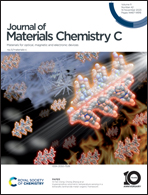Carboxylate BODIPY integrated in MOF-5: easy preparation and solid-state luminescence†
Abstract
Boron-dipyrromethenes (BODIPYs) are remarkable organic fluorophores widely used in solution. However, like many other organic phosphors, BODIPYs suffer from aggregation-caused quenching inhibiting the solid-state luminescence, which limits their potential for various applications. Metal–organic frameworks (MOFs), a well-known class of hybrid materials consisting of organic ligands bridging metal clusters, are considered herein as solid-state templates allowing restoration of the luminescence of BODIPY in the solid state. By a simple room-temperature synthetic procedure, we were able to integrate carboxylate functionalized BODIPYs into a MOF-5 structure (composed of {Zn4O}6+ clusters and terephthalate ligands). This allowed limiting solid-state aggregation phenomena. The structure and the morphology of different MOF@BODIPY samples have been characterized by XRD and/or microscopy. The luminescence properties have been characterized in the solid state and compared to BODIPY in solution. The MOF@BODIPY samples offer high external photoluminescence quantum yields of up to 27% in the solid state. Emission and excitation spectra were similar to those of BODIPY in solution. The amount of BODIPY integrated into the structures has been confirmed by UV-vis spectroscopy and an optimal loading has been determined. The thermo-stability and UV ageing have been preliminarily tested.



 Please wait while we load your content...
Please wait while we load your content...